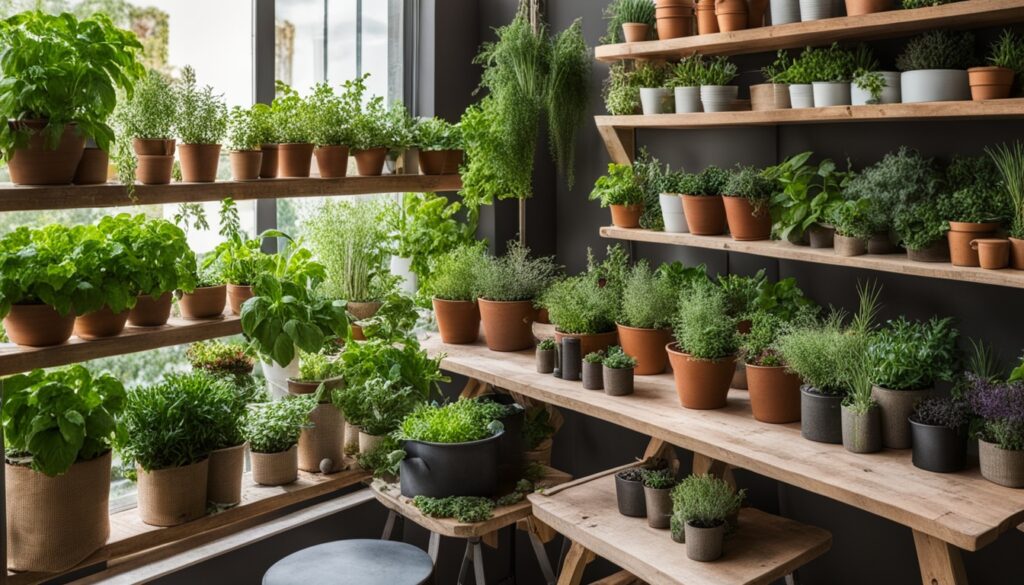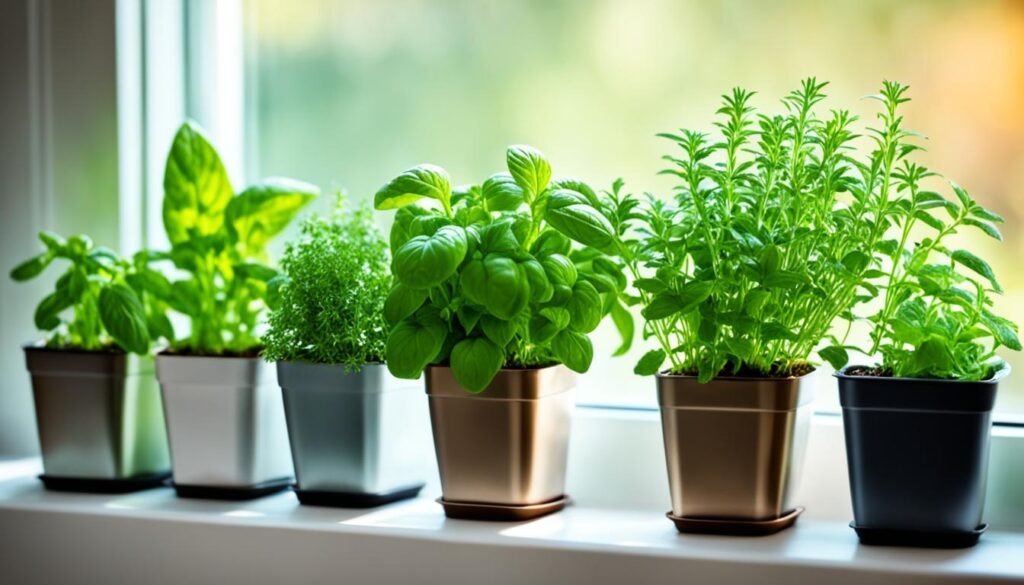Herbal Gardens for Beginners: Essential Herbs and Their Uses
Are you ready to make your cooking and wellness routine better with fresh, homegrown herbs? Starting a herbal garden is a rewarding journey. It brings nature’s flavors and healing properties right to your doorstep. This guide will help you create a thriving oasis of essential herbs at home.
Imagine stepping out to your patio and picking fresh basil for your pasta sauce. Or harvesting calming chamomile for your evening tea. With a bit of sunlight and care, you can grow many herbs. These herbs will make your cooking better and support your health. Let’s start this exciting green adventure and enjoy the joys of your own herbal garden.
Introduction to Herbal Gardening
Herbal gardening is a hobby that brings healing power from nature right to your home. It’s great for beginners who want to start an herb garden. You can grow plants for cooking, wellness, and making your home smell nice.
What is herbal gardening?
Herbal gardening is about growing plants for their flavors, smells, or health benefits. It’s an old practice that’s becoming popular again. You can start with a few pots on a sunny windowsill or use a part of your yard for these useful plants.
Benefits of growing your own herbs
Growing herbs has many benefits:
- Fresh ingredients for cooking
- Natural remedies for small health issues
- Plants that make your home smell nice
- A cheaper way to get herbs instead of buying them
- A green way to garden
Herb gardens are great for small spaces, making them perfect for city living. Many herbs do well in pots, so you can have a beautiful garden on a balcony or patio. With a little care and attention, your herb garden will do well. It will make your cooking and health routines better.
“To plant a garden is to believe in tomorrow.” – Audrey Hepburn
Start enjoying herbal gardening and see your green thumb grow with your plants. It’s a rewarding journey that connects you with nature and improves your life in many ways.
Getting Started with Herbal Gardening
Are you ready to start your herbal gardening journey? Let’s look at the basics of planting and caring for garden herbs. With these easy tips for setting up a DIY herb garden, you’ll quickly have a thriving herb oasis.
Choosing the Right Location
Finding the perfect spot for your herb garden is key. Most herbs need lots of sunlight, so pick a spot that gets at least 6 hours of direct sun each day. If you don’t have much outdoor space, don’t worry! Many herbs do well in containers, making them great for balconies or windowsills.

Soil and Light Requirements
Herbs do best in soil that drains well. If your garden soil is too heavy, add some sand or compost to help it drain better. For containers, choose terracotta pots. They’re not only pretty but also let excess water drain out.
While most herbs love the sun, some like a little shade, especially in hot places. Sage, for example, likes to cool off from the intense afternoon sun. When planning your garden, think about these needs:
- Full sun lovers: Basil, rosemary, thyme
- Partial shade fans: Mint, parsley, cilantro
Successful herb gardening is about watching and adjusting. Pay attention to your plants and they’ll show you what they need. With these tips, you’re all set to begin your exciting journey in herbal gardening!
Essential Herbs for Beginners
Starting your herbal garden journey? You’re in for a treat! Let’s explore some easy herbs for indoor gardening and the best herbs for small garden spaces. These beginner-friendly herbs will not only add flavor to your dishes but also bring a touch of green to your home.
Beginner-Friendly Herbs
Here’s a list of herbs perfect for new gardeners:
- Basil
- Rosemary
- Thyme
- Mint
- Oregano
- Parsley
- Cilantro
- Chives
- Dill

Herb Descriptions and Uses
Let’s dive into what makes these herbs special and how you can use them in your cooking:
| Herb | Description | Culinary Uses |
|---|---|---|
| Basil | Fragrant, sweet leaves | Italian dishes, pesto |
| Rosemary | Woody, needle-like leaves | Roasts, infused oils |
| Thyme | Small, delicate leaves | Soups, stews |
| Mint | Cool, refreshing flavor | Drinks, Mediterranean cuisine |
| Oregano | Strong, earthy taste | Pizza, tomato-based dishes |
These herbs are not only flavorful but also versatile. Parsley works great as a garnish, while cilantro adds zest to Mexican and Asian dishes. Chives bring a mild garlicky flavor, and dill pairs wonderfully with fish. With these easy herbs for indoor gardening, you’ll have a thriving herb garden in no time!
Planting and Caring for Your Herbs
Are you ready to start your herb garden? Let’s explore some easy DIY tips to help you begin. Creating a successful herb garden is simpler than you might think!
Step-by-Step Planting Guide
Here are the easy steps to plant your herbs:
- Choose well-draining soil for your herbs
- Ensure proper sunlight exposure for each herb variety
- Dig holes twice the size of the root balls
- Place herbs in holes and fill with soil
- Water thoroughly after planting
Watering, Fertilizing, and Pruning Tips
For healthy herbs, proper care is key. Water them regularly but don’t overdo it. Most herbs like the soil to be dry. Only fertilize a little, as they don’t need much. Prune them often to keep them bushy and prevent them from flowering, which can change their flavor.
| Herb | Watering | Fertilizing | Pruning |
|---|---|---|---|
| Basil | Every 3-4 days | Monthly | Weekly |
| Rosemary | When soil is dry | Rarely | As needed |
| Mint | Every 2-3 days | Monthly | Bi-weekly |
Each herb is different. Watch and adjust your care based on what you see and your garden’s conditions. With these tips, you’ll soon be enjoying fresh herbs!
Harvesting and Storing Herbs
Learning how to harvest and store fresh herbs can change your cooking and wellness routine. With the right methods, you can enjoy herbs all year. This will make your cooking better and your health remedies more effective.
When and How to Harvest Herbs
The best time to pick herbs is in the morning, after the dew is gone but before it gets too hot. This way, you get the best flavor and oil content. Cut stems just above a leaf intersection to help the plant grow more.
For leafy herbs like basil and cilantro, picking them often keeps the plant bushy and stops it from flowering.
Best Methods for Drying and Storing Herbs
Here are some ways to keep your herbs fresh:
- Fresh storage: Put cut herbs in water, cover with a plastic bag, and keep in the fridge.
- Drying: Hang herb bunches in a sunny spot until they are dry.
- Freezing: Chop herbs like chives and parsley, then freeze in ice cube trays with water or oil.
Some herbs, like tarragon, can be frozen or dried for later use. This gives you different ways to keep them.
| Herb | Best Preservation Method | Storage Duration |
|---|---|---|
| Basil | Freezing | Up to 6 months |
| Rosemary | Drying | Up to 1 year |
| Cilantro | Fresh in water | 1-2 weeks |
| Thyme | Drying or Freezing | Up to 1 year |
By learning these techniques, you’ll always have fresh flavors for your dishes and health goals all year.
Common Problems and Solutions in Herbal Gardening
Growing herbs can be rewarding, but it has its challenges. Let’s look at some common issues and herbal garden pest control tips to help your plants thrive.
Pests and Diseases to Watch Out For
Aphids and Japanese beetles often visit herb gardens. They can harm your plants if not controlled. Some herbs, like chives, can keep these pests away.
Basil is a popular herb but can face diseases. Wilts, leaf spots, and downy mildew can harm it. Keep plants well-spaced for good air flow to prevent these problems.
Troubleshooting Common Issues
Don’t overwater your herbs. This can cause root rot and damage them. Always check the soil moisture before watering.
Herbs like mint and oregano grow quickly. If not kept in check, they can take over your garden. Use containers for these herbs to control their spread.
Bolting is a problem for herbs like cilantro and dill. To avoid this, plant them in succession and harvest often. This way, you’ll have fresh herbs all season.
“The key to a thriving herb garden is vigilance. Observe your plants daily and address issues promptly.”
Knowing these common problems and solutions will help you keep your herb garden healthy and productive. Remember, gardening is a learning process. Don’t get discouraged by setbacks. With patience and practice, you’ll become an expert in herbal gardening.
Conclusion and Additional Tips
Growing your own herbal garden is a rewarding experience. It can change your cooking and wellness routine with fresh, homegrown herbs. By following the guide, you’ll get a thriving herb garden.
Recap of Key Points
Choose the right spot for your herbs, thinking about their needs. Plant them in soil that drains well and water them right. Harvesting often keeps your plants healthy and full of herbs.
Watch out for pests and diseases to spot problems early. This keeps your garden healthy.
Additional Tips for Success
Don’t hesitate to try new herb mixes in your cooking. Experiment with herbs like lemon balm or tarragon to improve your cooking. Companion planting helps your herbs and other plants in the garden.
Let some herbs flower to attract pollinators. This makes your garden healthier overall.
If you have little outdoor space, many herbs are great for indoor gardens. With the right care, your herbs can offer fresh flavors and natural remedies all year. Start small, learn as you go, and enjoy the world of homegrown herbs!
FAQ
What is herbal gardening?
What are the benefits of growing your own herbs?
What are some essential herbs for beginners?
How do I choose the right location for my herb garden?
How do I care for my herb plants?
When and how should I harvest my herbs?
What are some common problems and solutions in herbal gardening?
Source Links
- https://franksnurseryandcrafts.com/12-essential-herbs-for-your-kitchen-garden/ – 12 Essential Herbs for Your Kitchen Garden – Franks Nursery
- https://homesteadingfamily.com/medicinal-herbs-their-uses/ – Medicinal Herbs & Their Uses
- https://mynortherngarden.com/2023/01/01/__easy-herbs-beginning-gardeners/ – Easy Herbs for Beginning Gardeners – My Northern Garden
- 10 Must-Have Blooms for Your 2025 Garden
- The Health Advantages of Gardening You Need to Know
- How to Create a Small Vegetable Garden Layout Plan: A Beginner’s Guide
- DIY Garden Projects for Small Spaces: Upcycling Ideas to Maximize Your Garden
- Watering Techniques for Small Gardens: Ensuring Your Plants Thrive
- Small Border Plants for Landscaping: Adding Beauty and Functionality to Your Garden
- Year-Round Small Space Gardening: Seasonal Planting Tips for Maximum Harvest
- Essential Tools for Small-Space Gardening: What You Really Need
- The Ultimate Guide to Container Vegetables: What to Grow in Small Spaces
- Budget-Friendly Gardening: How to Create a Thriving Garden on a Tight Budget
- How to Optimize Sunlight in Small Gardens: Tips for Better Plant Growth
- DIY Vertical Planters: Creative Ideas for Small Space Gardening
- Companion Planting for Small Vegetable Gardens: Boost Growth and Deter Pests
- Container Gardening Essentials: Choosing the Right Pots, Soil, and Plants
- Vertical Gardening Techniques: Maximizing Your Small Space with Climbers and Vines
- How to Build a Raised Bed Garden in a Small Backyard: Step-by-Step Guide
- The Best Vegetables for Small-Space Gardens: High-Yield Varieties You Need to Grow
- Smart Vegetable Garden Layouts for Small Spaces: Maximizing Your Green Thumb in Compact Areas
- 40. Best Practices for Managing a Sustainable Garden Year-Round
- Building a Wildlife Pond for Biodiversity
- Advanced Techniques in Sustainable Gardening
- How to Create a No-Till Garden
- The Mental Health Benefits of Gardening
- Using Technology to Enhance Sustainable Gardening
- Getting Certified Organic: Steps and Benefits

Leave a Reply